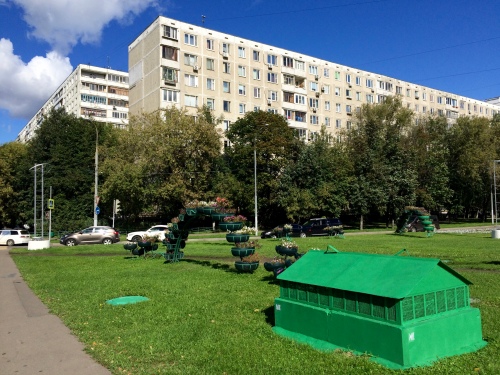
My apartment building (on the left), photographed in the sunny days of late August.
Although some of you have seen some of my Moscow pictures on Facebook, I’ve been remiss in posting here, so I’ll start with a simple post about my neighborhood. I live in Northern Chertanovo (Чертаново Северное), in the southern part of Moscow, about eight or nine miles south of Red Square (forty minutes by metro).
Chertanovo used to be a small village with an apple orchard, centered far from my apartment; apparently some of the apple trees can still be seen near the district council building (I still need to investigate). In the Second World War, it was the site of a training airfield. Finally, in 1960 it was incorporated into Moscow, and soon after many of the tall apartment buildings were built.
The story will be familiar to those who have seen the Soviet movie The Irony of Fate. After the initial animated sequence depicting marching rows of identical Soviet apartments taking over the world, the narrator gives a brief history:
Подмосковные деревни: Тропарево, Чертаново, Медведково, Беляево-Богородское, и, конечно же, Черемушки — не подозревали о том, что обретают бессмертие в те грустные для них дни, когда их навсегда сметали с лица земли. Деревня Черемушки дала свое имя московским новостройкам, которые расположились на юго-западе нашей столицы. Теперь чуть ли не в любом советском городе есть свои Черемушки. В былые времена, когда человек попадал в какой-нибудь незнакомый город, он чувствовал себя одиноким и потерянным. Вокруг все было чужое: иные дома, иные улицы, иная жизнь. Зато теперь совсем другое дело. Человек попадает в любой незнакомый город, но чувствует себя в нем, как дома. До какой нелепости доходили наши предки! Они мучились над каждым архитектурным проектом. А теперь во всех городах возводят типовой кинотеатр «Ракета», где можно посмотреть типовой художественный фильм.
The villages outside of Moscow—Troparyovo, Chertanovo, Medvedkovo, Belyaevo-Bogorodskoe, and of course Cheryomushki—never suspected that they would gain immortality in those days, sad for them, when they were swept away forever from the face of the earth. The village of Cheryomushki gave its name to the new buildings located in the south-west of Moscow. Now, practically every Soviet city has its own Cheryomushki. In the old days, if a person ended up in some unfamiliar town, he would feel lonely and lost. Everything around him was strange: different homes, different streets, a different life. But now things have changed. A person can arrive in an unfamiliar city but feel quite at home. How foolish our ancestors were! They agonized over every new architectural project. Now, every town has built a typical “Rocket” movie theater, where you can see a typical feature film.
My nearest movie theater is actually called “Formula Kino,” but the basic idea is still largely true. These “спальные районы” (sleeping districts), with their blocks of apartment buildings, inner courtyards, and various shops clustered around transport stations, are similar enough that you could travel to any city across Russia and not find many obvious differences. The same would be true for many former Soviet republics, although the language of the signs would be a giveaway.
Of course, this architectural conformism is not unique to the former Soviet Union. Many suburban developments and strip malls in the United States are equally conformist. But to me as a foreigner, even one who has been to Russia two times before, the different type of conformism is still striking. Nevertheless, as I spend more time in Chertanovo, I continue discovering small differences and unusual points of interest, which I hope to write about more in future posts.


